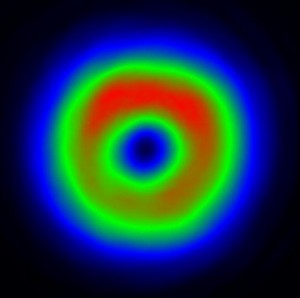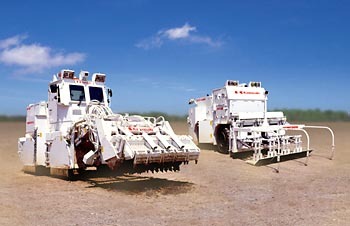 Researchers at Kyoto University have developed new semiconductor laser technology that allows the shape of beams to be tailored freely and that can output beams up to 10 times more compact than existing beams ? a development that could lead to a tenfold increase in the storage capacity of optical discs. Research results were published in the June 22 edition of British science journal Nature.
Researchers at Kyoto University have developed new semiconductor laser technology that allows the shape of beams to be tailored freely and that can output beams up to 10 times more compact than existing beams ? a development that could lead to a tenfold increase in the storage capacity of optical discs. Research results were published in the June 22 edition of British science journal Nature.
The Kyoto University group, led by professor Susumu Noda, worked with Kyoto-based Rohm Co., Ltd. and the Japan Science and Technology Agency (JST) to engineer layers of photonic crystals consisting of tens of thousands of small holes, which were incorporated into 0.5 mm x 0.5 mm semiconductor chips. The photonic crystal layer works as an optical resonator, with each individual hole functioning as a tiny mirror that causes the light to resonate in the semiconductor until it is emitted as laser light. The result is a laser beam with a diameter up to 10 times smaller and with properties different from those of conventional semiconductor lasers.
According to the researchers, these new semiconductor lasers were able to produce a range of beam patterns while maintaining stable single-mode oscillation. The ability to control the oscillation direction of light in this way could lead to the development of compact lasers capable of producing diverse beam patterns on demand, such as hollow beams (with cross-sections that look like donuts), concentric hollow beams (donuts within donuts), and other shapes that have heretofore been impossible to form.
Controlling the oscillation direction of light also means that lasers can be focused into ultra-thin beams, enabling a tenfold increase in the density of data storage on discs without changing the wavelength of the laser. Using blue lasers such as those used in Blu-ray disc technology could lead to DVDs with hundreds of gigabytes of capacity.
Potential applications are not limited to ultra-high density storage media. Ultra-thin, hollow beams could be used as "tweezers" for trapping and moving microscopic particles, which could bring a new level of precision to molecular-level processing and fabrication. Hidemi Takasu, Rohm's research director, says, "In addition to seeing our research applied to next-generation DVD technology, we hope it can be applied to imaging technology that uses lasers to project precise images directly onto the human retina."
[Sources: Yomiuri Shimbun, Kyoto Shimbun, JST press release]

 On June 21,
On June 21,  On June 21, researchers at Waseda University's Institute of Egyptology unveiled the computer-generated facial image of an ancient Egyptian military commander that lived about 3,800 years ago. The image is based on CAT scans taken of a mummy.
On June 21, researchers at Waseda University's Institute of Egyptology unveiled the computer-generated facial image of an ancient Egyptian military commander that lived about 3,800 years ago. The image is based on CAT scans taken of a mummy. On June 20, an Okayama University team of researchers led by Professor Shogo Minagi unveiled a nasal airflow regulator designed to alleviate voice loss such as that which sometimes occurs after a stroke.
On June 20, an Okayama University team of researchers led by Professor Shogo Minagi unveiled a nasal airflow regulator designed to alleviate voice loss such as that which sometimes occurs after a stroke.









 "It?s dirty, but everyone is interested in poop. I wanted to give it a try," says Michinori Ueda, director of
"It?s dirty, but everyone is interested in poop. I wanted to give it a try," says Michinori Ueda, director of